Biology:Tyrant flycatcher
| Tyrant flycatchers | |
|---|---|
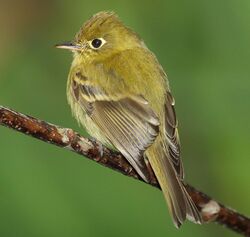
| |
| Yellowish flycatcher, Empidonax flavescens | |
| Scientific classification | |
| Domain: | Eukaryota |
| Kingdom: | Animalia |
| Phylum: | Chordata |
| Class: | Aves |
| Order: | Passeriformes |
| Parvorder: | Tyrannida |
| Family: | Tyrannidae Vigors, 1825 |
| Type genus | |
| Tyrannus | |
| Genera | |
|
Some 100, see text | |

| |
| Distribution of tyrant flycatchers | |
The tyrant flycatchers (Tyrannidae) are a family of passerine birds which occur throughout North and South America.[1] They are considered the largest family of birds known to exist in the world, with more than 400 species. They are the most diverse avian family in every country in the Americas, except for the United States and Canada . The members vary greatly in shape, patterns, size and colors. Some tyrant flycatchers may superficially resemble the Old World flycatchers, which they are named after but are not closely related to. They are members of suborder Tyranni (suboscines), which do not have the sophisticated vocal capabilities of most other songbirds.[2]
A number of species previously included in this family are now placed in the family Tityridae (see Systematics). Sibley and Alquist in their 1990 bird taxonomy had the genera Mionectes, Leptopogon, Pseudotriccus, Poecilotriccus, Taenotriccus, Hemitriccus, Todirostrum and Corythopis as a separate family Pipromorphidae,[3] but although it is still thought that these genera are basal to most of the family, they are not each other's closest relatives.[3]
Description
Most, but not all, species are rather plain, with various hues of brown, gray and white commonplace, often providing some degree of presumed camouflage. Obvious exceptions include the bright red vermilion flycatcher, blue, black, white and yellow many-colored rush-tyrant and some species of tody-flycatchers or tyrants, which are often yellow, black, white and/or rufous, from the Todirostrum, Hemitriccus and Poecilotriccus genera. Several species have bright yellow underparts, from the ornate flycatcher to the great kiskadee. Some species have erectile crests. Several of the large genera (i.e. Elaenia, Myiarchus or Empidonax) are quite difficult to tell apart in the field due to similar plumage and some are best distinguished by their voices. Behaviorally they can vary from species such as spadebills which are tiny, shy and live in dense forest interiors to kingbirds, which are relatively large, bold, inquisitive and often inhabit open areas near human habitations. As the name implies, a great majority of tyrant flycatchers are almost entirely insectivorous (though not necessarily specialized in flies). Tyrant flycatchers are largely opportunistic feeders and often catch any flying or arboreal insect they encounter. However, food can vary greatly and some (like the large great kiskadee) will eat fruit or small vertebrates (e.g. small frogs). In North America, most species are associated with a "sallying" feeding style, where they fly up to catch an insect directly from their perch and then immediately return to the same perch. Most tropical species, however, do not feed in this fashion and several types prefer to glean insects from leaves and bark. Tropical species are sometimes found in mixed-species foraging flocks, where various types of passerines and other smallish birds are found feeding in proximity.
The smallest family members are the closely related short-tailed pygmy tyrant and black-capped pygmy tyrant from the genus Myiornis (the first species usually being considered marginally smaller on average). These species reach a total length of 6.5–7 cm (2.6–2.8 in) and a weight of 4 to 5 g (0.14 to 0.18 oz). By length, they are the smallest passerines on earth, although some species of Old World warblers apparently rival them in their minuscule mean body masses if not in total length.[4] The minuscule size and very short tail of the Myiornis pygmy tyrants often lend them a resemblance to a tiny ball or insect. The largest tyrant flycatcher is the great shrike-tyrant at 29 cm (11 in) and 99.2 grams (0.219 pounds). A few species such as the streamer-tailed tyrant, scissor-tailed flycatcher and fork-tailed flycatcher have a larger total length — up to 41 cm (16 in) in the fork-tailed flycatcher at least — but this is mainly due to their extremely long tails; the fork-tailed flycatcher has the longest tail feathers of any known bird relative to their size (this being in reference to true tail feathers, not to be confused with elongated tail streamers as seen in some from the Phasianidae family of galliforms).[5]
Habitat and distribution
Species richness of Tyrannidae, when compared to habitat, is highly variable, although most every land habitat in the Americas has at least some of these birds. The habitats of tropical lowland evergreen forest and montane evergreen forest have the highest single site species diversity while many habitats including rivers, palm forest, white sand forest, tropical deciduous forest edge, southern temperate forest, southern temperate forest edge, semi-humid/humid montane scrub, and northern temperate grassland have the lowest single species diversity. The variation between the highest and the lowest is extreme; ninety species can be found in the tropical lowland evergreen forests while the number of species that can be found in the habitats listed above typically are in the single digits. This may be due in part to the fewer niches found in certain areas and therefore fewer places for the species to occupy.
Tyrannidae specialization among habitats is very strong in tropical lowland evergreen forests and montane evergreen forests. These habitat types, therefore, display the greatest specialization. The counts differ by three species (tropical lowland evergreen forests have 49 endemic species and montane evergreen forests have 46 endemic species). It can be assumed that they both have similar levels of specialization.
Regionally, the Atlantic Forest has the highest species richness with the Chocó following closely behind.
Status and conservation
The northern beardless tyrannulet (Camptostoma imberbe) is protected under the Migratory Bird Treaty Act of 1918.[6] This species is common south of the US border. The situation for a number of other species from South and Central America is far more problematic. In 2007, BirdLife International (and consequently IUCN) considered two species, the Minas Gerais tyrannulet and Kaempfer's tody-tyrant critically endangered. Both are endemic to Brazil. Additionally, seven species were considered endangered and eighteen species vulnerable.[7]
Systematics
The family contains 447 species divided into 104 genera.[8] A full list, sortable by common and binomial names, is at list of tyrant flycatcher species. Species in the genera Tityra, Pachyramphus, Laniocera and Xenopsaris were formerly placed in this family, but evidence suggested they belong in their own family, the Tityridae,[9] where they are now placed by SACC.
| Image | Genus | Species |
|---|---|---|
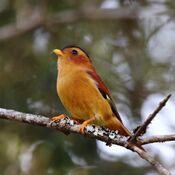 |
Piprites Cabanis, 1847 |
|
 |
Phyllomyias Cabanis & Heine, 1859 |
|
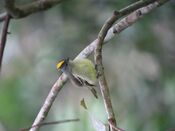 |
Tyrannulus Vieillot, 1816 |
|
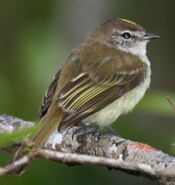 |
Myiopagis Salvin & Godman, 1888 |
|
 |
Elaenia Sundevall, 1836 |
|
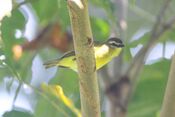 |
Ornithion Hartlaub, 1853 |
|
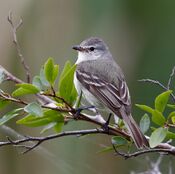 |
Camptostoma P.L. Sclater, 1857 |
|
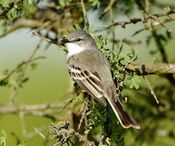 |
Suiriri d'Orbigny, 1840 |
|
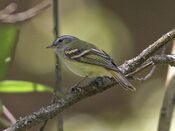 |
Mecocerculus P.L. Sclater, 1862 |
|
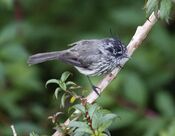 |
Anairetes Reichenbach, 1850 |
|
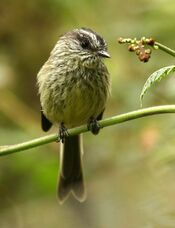 |
Uromyias Hellmayr, 1927 |
|
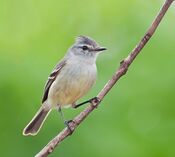 |
Serpophaga Gould, 1839 |
|
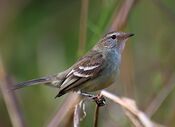 |
Nesotriccus Townsend, CH, 1895 |
|
 |
Capsiempis Cabanis & Heine, 1859 |
|
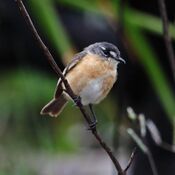 |
Polystictus Reichenbach, 1850 |
|
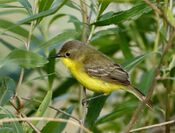 |
Pseudocolopteryx Lillo, 1905 |
|
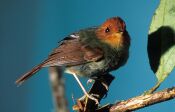 |
Pseudotriccus Taczanowski & Berlepsch, 1885 |
|
 |
Corythopis Sundevall, 1836 |
|
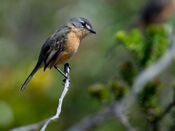 |
Euscarthmus Wied-Neuwied, 1831 |
|
 |
Pseudelaenia W. Lanyon, 1988 |
|
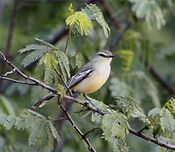 |
Stigmatura Sclater & Salvin, 1866 |
|
 |
Zimmerius Traylor, 1977 |
|
 |
Pogonotriccus Cabanis & Heine, 1859 |
|
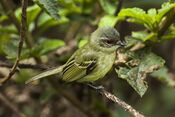 |
Phylloscartes Cabanis & Heine, 1859 |
|
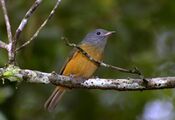 |
Mionectes Cabanis, 1844 |
|
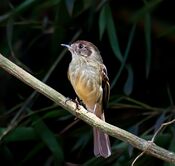 |
Leptopogon Cabanis, 1844 |
|
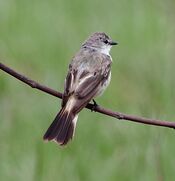 |
Guyramemua Lopes et al., 2017 |
|
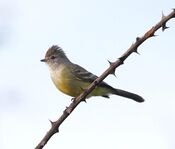 |
Sublegatus Sclater & Salvin, 1868 |
|
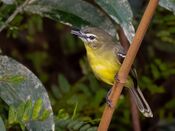 |
Inezia Cherrie, 1909 |
|
 |
Myiophobus Reichenbach, 1850 |
|
 |
Nephelomyias (Ohlson, Fjeldsa and Ericson, 2009) |
|
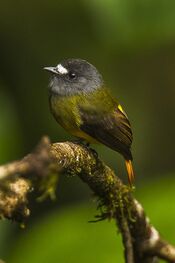 |
Myiotriccus Ridgway, 1905 |
|
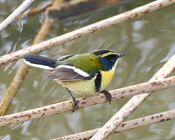 |
Tachuris Lafresnaye, 1836 |
|
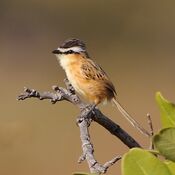 |
Culicivora Swainson, 1827 |
|
 |
Hemitriccus Cabanis & Heine, 1859 |
|
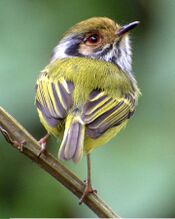 |
Myiornis Bertoni, A.W., 1901 |
|
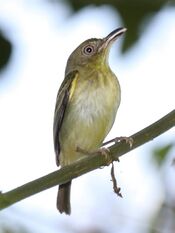 |
Oncostoma P.L. Sclater, 1862 |
|
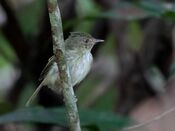 |
Lophotriccus Berlepsch, 1884 |
|
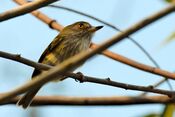 |
Atalotriccus Ridgway, 1905 |
|
 |
Poecilotriccus Berlepsch, 1884 |
|
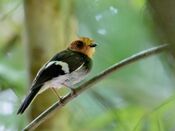 |
Taeniotriccus Berlepsch & Hartert, 1902 |
|
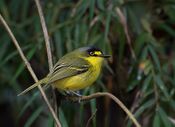 |
Todirostrum – typical tody-flycatchers Lesson, 1831 |
|
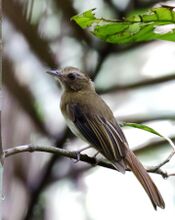 |
Cnipodectes P.L. Sclater & Salvin, 1873 |
|
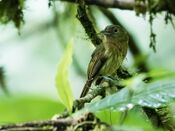 |
Rhynchocyclus Cabanis & Heine, 1859 |
|
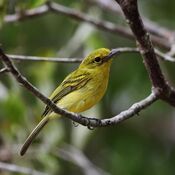 |
Tolmomyias Hellmayr, 1927 |
|
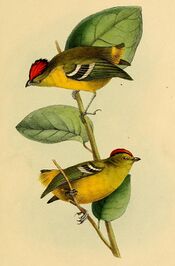 |
Calyptura Swainson, 1832 |
|
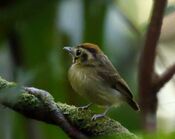 |
Platyrinchus Desmarest, 1805 |
|
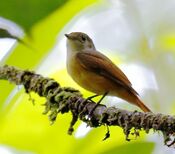 |
Neopipo Sclater & Salvin, 1869 |
|
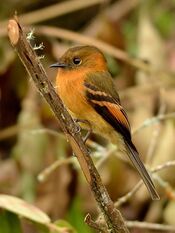 |
Pyrrhomyias Cabanis & Heine, 1859 |
|
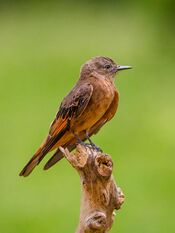 |
HirundineaOrbigny & Lafresnaye, 1837 |
|
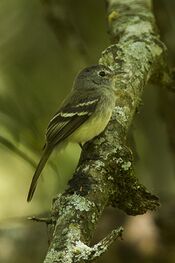 |
Lathrotriccus Lanyon,W & Lanyon,S, 1986 |
|
 |
Aphanotriccus Ridgway, 1905 |
|
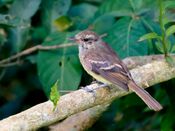 |
Cnemotriccus Hellmayr, 1927 |
|
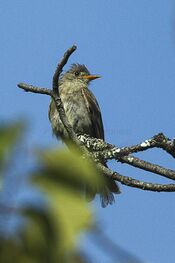 |
Xenotriccus Dwight & Griscom, 1927 |
|
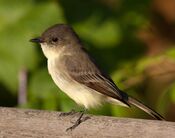 |
Sayornis – phoebes Bonaparte, 1854 |
|
 |
Mitrephanes Coues, 1882 |
|
 |
Contopus Cabanis, 1855 |
|
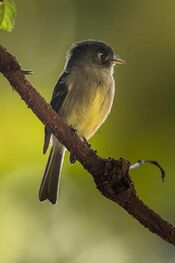 |
Empidonax Cabanis, 1855 |
|
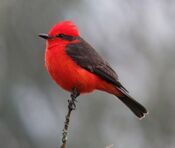 |
Pyrocephalus Gould, 1839 |
|
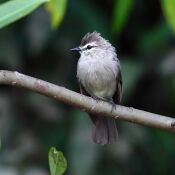 |
Ochthornis P.L. Sclater, 1888 |
|
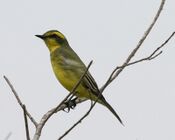 |
Satrapa Strickland, 1844 |
|
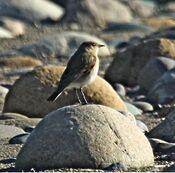 |
Syrtidicola Chesser et al, 2020 |
|
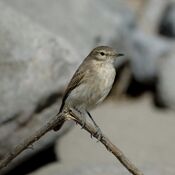 |
Muscisaxicola – ground tyrants Orbigny & Lafresnaye, 1837 |
|
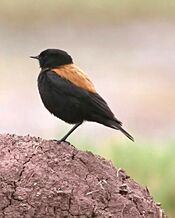 |
Lessonia Swainson, 1832 |
|
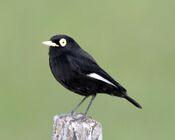 |
Hymenops Lesson, 1828 |
|
 |
Knipolegus F. Boie, 1826 |
|
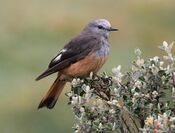 |
Cnemarchus Ridgway, 1905 |
|
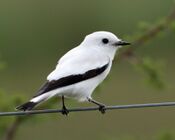 |
Xolmis F. Boie, 1826 |
|
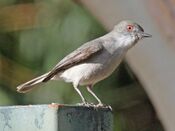 |
Pyrope Cabanis & Heine, 1860 |
|
 |
Nengetus Swainson, 1827 |
|
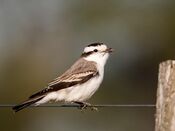 |
Neoxolmis Hellmayr, 1927 |
|
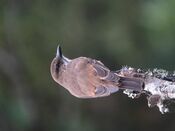 |
Myiotheretes Reichenbach, 1850 |
|
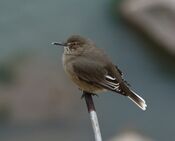 |
Agriornis – shrike-tyrants Gould, 1839 |
|
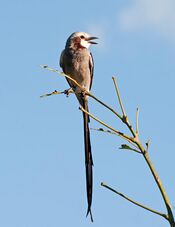 |
Gubernetes Such, 1825 |
|
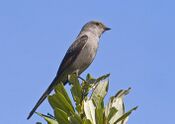 |
Muscipipra Lesson, 1831 |
|
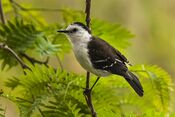 |
Fluvicola Swainson, 1827 |
|
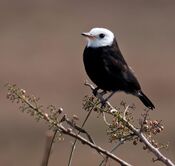 |
Arundinicola d'Orbigny, 1840 |
|
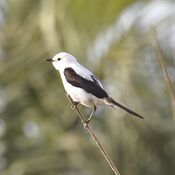 |
Heteroxolmis Lanyon, W, 1986 |
|
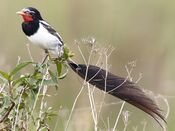 |
Alectrurus Vieillot, 1816 |
|
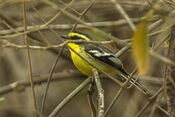 |
Tumbezia Chapman, 1925 |
|
 |
Silvicultrix Lanyon, W, 1986 |
|
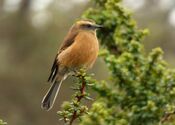 |
Ochthoeca Cabanis, 1847 |
|
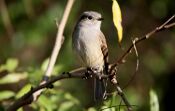 |
Colorhamphus Sundevall, 1872 |
|
 |
Colonia |
|
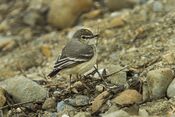 |
Muscigralla Orbigny & Lafresnaye, 1837 |
|
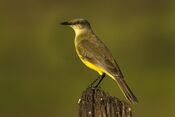 |
Machetornis G.R. Gray, 1841 |
|
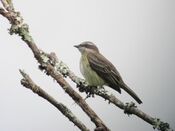 |
Legatus P.L. Sclater, 1859 |
|
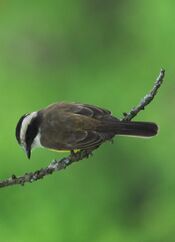 |
Phelpsia W. Lanyon, 1984 |
|
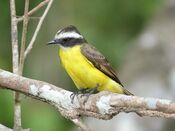 |
Myiozetetes P.L. Sclater, 1859 |
|
 |
Pitangus Swainson, 1827 |
|
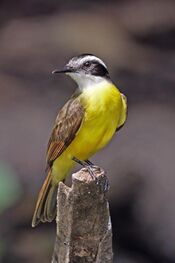 |
Philohydor Lanyon, W, 1984 |
|
 |
Conopias Cabanis & Heine, 1859 |
|
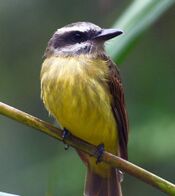 |
Myiodynastes Bonaparte, 1857 |
|
 |
Megarynchus Thunberg, 1824 |
|
 |
Tyrannopsis Ridgway, 1905 |
|
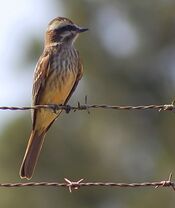 |
Empidonomus Cabanis & Heine, 1859 |
|
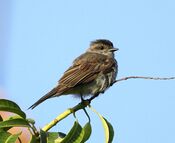 |
Griseotyrannus W.E. Lanyon, 1984 |
|
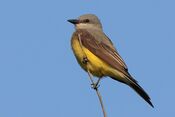 |
Tyrannus Lacépède, 1799 |
|
 |
Rhytipterna Reichenbach, 1850 |
|
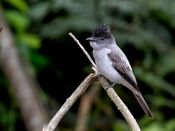 |
Sirystes Cabanis & Heine, 1859 |
|
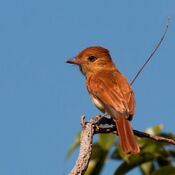 |
Casiornis Des Murs , 1856 |
|
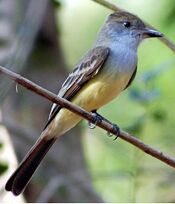 |
Myiarchus Cabanis, 1844 |
|
 |
Ramphotrigon G.R. Gray, 1855 |
|
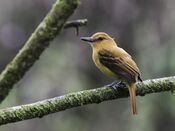 |
Attila Lesson, 1831 |
|
See also
References
- ↑ "Tyrant flycatchers « IOC World Bird List". http://www.worldbirdnames.org/bow/flycatchers/.
- ↑ del Hoyo, J. Elliott, A. & Christie, D. (editors). (2004) Handbook of the Birds of the World. Volume 9: Cotingas to Pipits and Wagtails. Lynx Edicions. ISBN:84-87334-69-5
- ↑ 3.0 3.1 Rheindt, F.E.; Norman, J.A.; Christidis, L. (2008). "Phylogenetic relationships of tyrant-flycatchers (Aves: Tyrannidae), with an emphasis on the elaeniine assemblage". Molecular Phylogenetics and Evolution 46 (1): 88–101. doi:10.1016/j.ympev.2007.09.011. PMID 18042406. http://www.bio-nica.info/biblioteca/Rheindt2007Aves.pdf. Retrieved 2012-08-05.
- ↑ CRC Handbook of Avian Body Masses, 2nd Edition by John B. Dunning Jr. (Editor). CRC Press (2008), ISBN:978-1-4200-6444-5.
- ↑ Bird, David Mitchell (2004). The Bird Almanac: A Guide to Essential Facts and Figures of the World's Birds. Buffalo, NY, USA: Firefly Books. p. 70. ISBN 978-1-55297-925-9. https://books.google.com/books?id=HTX6BatQFDgC&pg=PA70. Retrieved 2016-11-24.
- ↑ "List of Migratory Bird Species Protected by the Migratory Bird Treaty Act as of December 2, 2013" U.S. Fish and Wildlife Service
- ↑ BirdLife International (2007). Species factsheets. Accessed 12 December 2007 available online
- ↑ Gill, Frank; Donsker, David; Rasmussen, Pamela, eds (December 2023). "Tyrant flycatchers". IOC World Bird List Version 14.1. International Ornithologists' Union. https://www.worldbirdnames.org/bow/flycatchers/.
- ↑ Adopt the Family Tityridae – South American Classification Committee (2007)
Further reading
- Fjeldså, J.; Ohlson, J.I.; Batalha Filho, H.; Ericson, P.G.P.; Irestedt, M. (2018). "Rapid expansion and diversification into new niche space by fluvicoline flycatchers". Journal of Avian Biology 49 (3): jav-01661. doi:10.1111/jav.01661.
- Ohlson, J.I.; Irestedt, M.; Batalha Filho, H.; Ericson, P.G.P.; Fjeldså, J. (2020). "A revised classification of the fluvicoline tyrant flycatchers (Passeriformes, Tyrannidae, Fluvicolinae)". Zootaxa 4747 (1): 167–176. doi:10.11646/zootaxa.4747.1.7. PMID 32230123.
- Tello, J.G.; Moyle, R.G.; Marchese, D.J.; Cracraft, J. (2009). "Phylogeny and phylogenetic classification of the tyrant flycatchers, cotingas, manakins, and their allies (Aves: Tyrannides)". Cladistics 25 (5): 429–467. doi:10.1111/j.1096-0031.2009.00254.x. PMID 34879622.
External links
- Tyrant flycatcher videos, photos and sounds – Internet Bird Collection
 Ingersoll, Ernest (1920). "Flycatcher". Encyclopedia Americana.
Ingersoll, Ernest (1920). "Flycatcher". Encyclopedia Americana.
Wikidata ☰ Q217478 entry
 |

